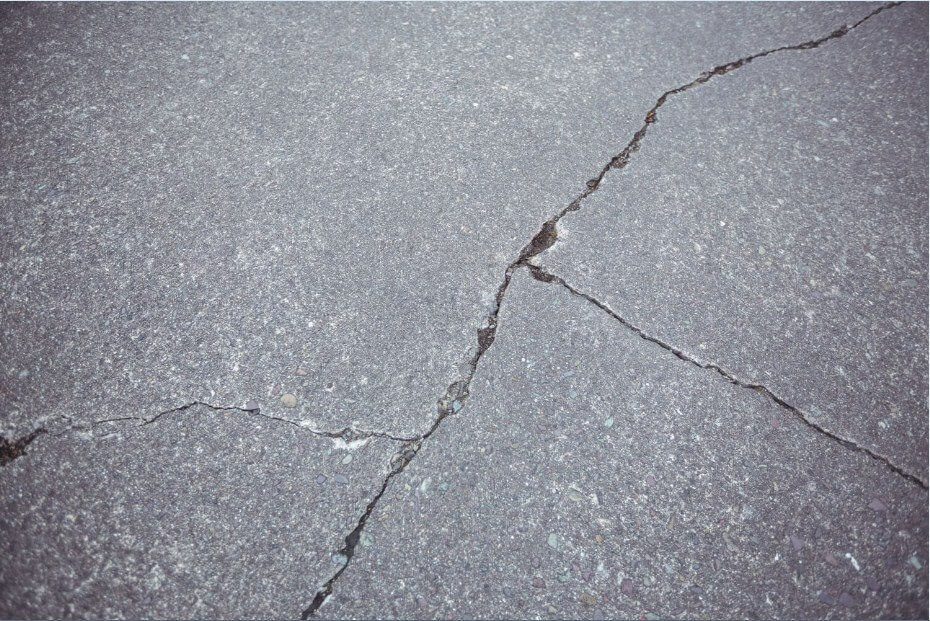Table of Contents
Understanding Basement Floor Cracks
Hey there, Chicago homeowner! Noticed a quirky line snaking across your basement floor? Yep, that might be more than just a mark—it’s a crack, but don’t panic yet! Let’s chew over what this could mean for your cozy nest down in the Windy City.
First off, it’s common to spot these unexpected guests on your basement floor, especially with our notorious Chicago winters and the thaw-and-freeze shenanigans. Imagine this: it’s like your concrete is trying to stretch after a long nap but doesn’t quite get it right—crack! These splits can range from hair-thin lines that are more annoying than harmful, to gapping fissures that make you wonder if the underworld is trying to say hello.
Now, the skinny lines, or as the pros call them, hairline cracks, are generally mild-mannered. They’re the kind of cracks that might widen their eyes a bit during a particularly frosty winter but typically stay put without throwing a fit. Think of them as the fine lines we all get with age—character marks, really!
But then, there are those structural cracks—the big baddies. These are the ones that look like they’ve been lifting weights, wider and more menacing. They don’t just sit pretty; they invite trouble, like water seepage, which in our world of basements is about as welcome as a skunk at a lawn party.
Causes of Basement Floor Cracks in Chicago Homes
Understanding the causes of basement floor cracks in Chicago homes can help you better manage and prevent potential issues. Here’s a straightforward breakdown:
- Natural Soil Settlement: The soil beneath your home naturally settles over time, which can create uneven pressure on the foundation, leading to cracks.
- Expansive Soil: In some areas of Chicago, the soil contains clay that expands when wet and shrinks when dry. This movement can stress the concrete floor of your basement, causing cracks.
- Freeze-Thaw Cycles: Chicago’s harsh winters can lead to freeze-thaw cycles where water seeps into small crevices, freezes, expands, and then thaws. This cycle can widen existing cracks or create new ones.
- Hydrostatic Pressure: This occurs when groundwater builds up in the soil around your foundation. The pressure from this buildup can push against the basement walls and floor, leading to cracks.
- Poor Drainage: Inadequate drainage around your home can cause excess water to accumulate near the foundation, exacerbating problems with hydrostatic pressure and soil expansion.
- Construction Issues: Mistakes made during the construction of your home, such as improper curing of concrete, use of low-quality materials, or inadequate compaction of the subsoil, can all lead to foundational weaknesses manifesting as cracks.
Immediate Steps to Take After Discovering a Crack
Hey there, Chicagoland homeowner! So, you’ve just stumbled upon a crack in your basement floor. Before you start reminiscing about that horror movie with the ominous basement scenes, let’s get practical and figure out how to handle this like a pro.
First, take a deep breath. It’s just a crack, not a gateway to another dimension (though that would be kind of cool, wouldn’t it?). Now, let’s roll up our sleeves and dive in.
Step One: Size it Up
Grab your trusty tape measure and get close—really close. You need to see how wide and long this crack has decided to be. If it’s thinner than a credit card, it’s likely not a giant monster waiting to eat your house (phew!). But keep an eye on it; like that oddball relative we all have, it might get wider over the holidays (thanks to Chicago’s festive freeze-thaw cycles).
Step Two: Dry the Scene
Next up, make sure your basement isn’t turning into a swimming pool. If you’ve got leaks, it’s time to channel your inner handyman. Check your gutters and downspouts—yes, that means a little trip outside (don’t forget your coat). Make sure they’re not clogged with last fall’s leaves or, heaven forbid, an actual squirrel’s nest.
Step Three: Document the Drama
Now, grab your smartphone. No, not for a doom-scroll on social media, but to snap some pictures of the crack. These pics aren’t just for your next thrilling slideshow presentation at family game night; they’re essential for keeping track of any changes in the crack over time.
Step Four: Seal the Deal
For those little, non-threatening cracks, you might consider a DIY sealant. It’s like putting a Band-Aid on a tiny scrape. You can find sealants at your local hardware store—just ask the folks there for a waterproofing sealant that laughs in the face of moisture. Remember, applying sealant is like painting: prep the area, make it clean, and go for it. Smooth moves only!
Step Five: Call in the Cavalry
If that crack looks more like the Grand Canyon than a hairline, or if you’re just not into DIY, it’s time to call professionals. These folks have seen it all, and they can offer solutions that are more robust than your internet search history.
Pro Tip: Keep a list of local contractors or a handyman service saved in your phone or on your fridge. It’s like having the Ghostbusters on speed dial, but for basement cracks.
Remember: The sooner you address the issue, the less likely it is to escalate into a full-blown foundation opera, with all the dramatic arias you can do without.
Long-Term Solutions for Basement Floor Cracks
Alright, folks, let’s talk long-term solutions for those pesky basement cracks that seem to have made your basement floor their new favorite playground.

Get to Know Your Foundation
First things first, let’s get intimate with your foundation. Just like understanding a family recipe passed down through generations, knowing the ins and outs of your foundation is key. Why? Because not all cracks are born equal, and neither are their solutions.
Call in the Experts
I know, I know, DIY can be tempting, especially with all those videos online. But when it comes to the integrity of your home’s foundation, it’s wise to bring in a professional. These folks are like the detectives of construction—they can sniff out a problem’s source faster than you can say “basement crack.” They might recommend solutions like underpinning (which isn’t as scary as it sounds) or more extensive waterproofing.
Waterproofing Wonders
Speaking of waterproofing, let’s chat about making your basement waterproof. No, it’s not like putting a giant raincoat around your house, though that’s a funny image! Waterproofing usually involves applying sealants inside and out, and sometimes installing a sump pump to keep water from partying down there. It’s about creating a barrier that tells water, “You shall not pass!”
Manage That Water
Water management outside is just as crucial. Think about gutters and downspouts like the veins and arteries of your house. They need to be clear to carry water away from your foundation effectively. Extend downspouts away from your house—like giving water a nice slide to play on, far from your basement.
Landscape with Love
And while we’re out there, let’s talk landscaping. Strategic landscaping isn’t just for curb appeal. Plants and grading (that’s how the ground slopes away from your house) can be your silent heroes, directing water away from your foundation. Choose plants that absorb lots of water and make sure the soil slopes away from your house. It’s like setting up a little traffic sign for water: “This way, please, and away from the house.”
Monitor and Maintain
Last but not least, make monitoring your basement part of your routine. It’s like checking in on an old friend. Regular checks can help catch new or expanding cracks before they become gaping gateways to the underworld (or just really expensive repairs). Plus, it gives you peace of mind, and who doesn’t love that?
When to Contact a Professional
So, you’ve spotted a crack in your basement and are wondering whether it’s time to call in the pros.
Check the Crack’s Personality
First things first, get familiar with the crack. Is it thin and quiet, barely there like a whisper? Or is it loud and proud, widening as if it’s trying to make a statement? Small, hairline cracks might just need a watchful eye and routine checks, kind of like keeping tabs on a quiet kid at a party. But when they start spreading out like they’re trying to explore the Great Plains, it’s time to raise the flag.
Water Signs are a Game Changer
Water stains or actual leakage around a crack are like uninvited guests who decide to stay for dinner—and breakfast. Dampness isn’t just a minor inconvenience; it’s a call to arms. Water can lead to mold, and nobody wants a mold party in their basement. It’s musty, it’s messy, and it’s downright unhealthy.
Listening to Your House’s Cries for Help
If you hear creaking, groaning, or any noises that remind you of a haunted house flick, it’s not just spooky—it’s a signal. These sounds can mean that the structure is shifting more than your uncle at a dance party after too many tacos. This kind of movement can cause significant damage, not just to your basement but potentially to the entire structure of your home.
Crack Growth: More Rapid than a Teenager
Keeping an eye on how fast a crack grows is crucial. If you notice that it’s getting bigger with every season change, it’s not just being dramatic. Rapid growth in cracks is a serious sign that the underlying structure of your home might be under stress.
When DIY Becomes “Don’t Involve Yourself”
Let’s face it, DIY can be great. It’s empowering, it can be fun (sort of), and it feels awesome to say, “I fixed that.” But sometimes, it’s like trying to perform a symphony with a kazoo; you’re just not equipped. If the problem seems bigger than what a YouTube tutorial and a trip to the hardware store can handle, it’s time to call professionals who can handle the repair.
Safety First, Always
Never underestimate the peace of mind that comes from knowing a professional has things under control. If there’s ever any doubt about the safety of your home, especially when it comes to structural integrity, err on the side of caution. These are the experts who can ensure your home stays standing strong, keeping you and your loved ones safe.
FAQ’s
Basement cracks can form due to natural soil settlement, changes in moisture levels, fluctuating temperatures, poor construction, or hydrostatic pressure from groundwater.
A crack is considered serious if it’s wider than a quarter-inch, grows noticeably over time, is accompanied by other signs of structural issues (like wall bowing), or leaks water.
Yes, minor cracks (hairline and not leaking water) can often be repaired with DIY epoxy or urethane injection kits that fill and seal the cracks.
Professional crack repair can involve various methods depending on the severity and cause, including epoxy injections, carbon fiber strips, underpinning, and extensive waterproofing measures.
It’s good practice to inspect your basement for cracks at least twice a year, typically in the spring and fall, to catch any new developments or changes in existing cracks.

